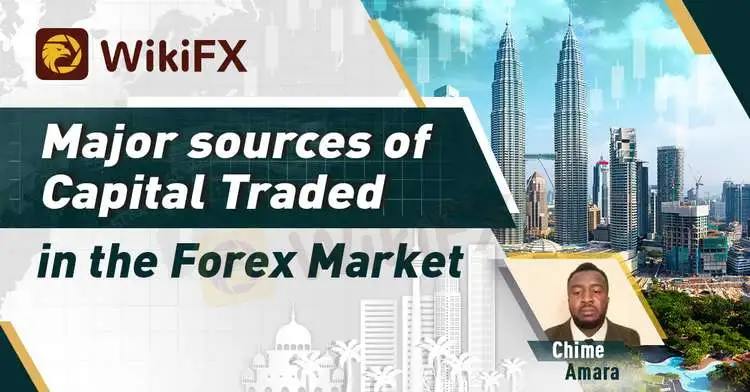Major sources of Capital Traded in the Forex Market
Abstract:Very often many traders get curious when they hear that the forex market has the largest amount of capital investment in the world with over 6.2 Trillion dollars invested and roughly 1.5 Trillion dollars traded daily. Some pause to argue where these large capitals come from. To this end, we have discussed extensively in the article, the major sources of the Capital traded in the forex market today.

By: Chime Amara

Major sources of Capital traded in the forex market.
There are mainly six major contributors of the capital traded in the forex market today. These players encompass both the big banks, institutions, government, hedge fund and retail traders. Below is the list of these players in the forex market today:
· Central Banks: The Central Banks are the liquidity providers in the forex market. They set the rate at which various currencies could be exchanged. The reason why they are called liquidity providers owes to the fact that they supply the commercial banks with the foreign currencies to be exchanged at the counter (OTC).
· Commercial Banks: Commercial banks are no doubt the biggest players in the forex market today. They contribute over 70% of the capital traded in the forex market. Their positions move the market more than any other. Hence, most retail traders tend to study the direction taken by these banks to guide them in making their own decisions. The major commercial banks are in the industry are: Citi Bank 6.9%, JP Morgan 7.9%, UBS 6.2%, Barclays Bank 5.7%, Deutsche Bank 7.2%, BAML 4.2%, Goldman Sachs 8.3%, HSBC 7.3%, Morgan Stanley 8.2%, XTX Markets 5.1%, etc.
· Government: Government bodies are the third significant players in the forex market today. They contribute over 8% of the capital traded in the forex market. They are often long-term investors. Often they preserved the country's savings in different currencies to hedge against inflations.
· Hedge Fund: This is made up of a large sum of money contributed by individuals and given to an expert to trade on their behalf and deliver profits to the owners. The total amount contributed by these wealthy individuals is often so large; measuring over 5% of the capital traded in the forex market today.
· Institutions: Many big firms are known to participate in the forex market. Through forex trading, various institutions can beat inflations and sustain their business. Also, multi-national corporations can maintain their branches in different countries through forex trading. Over 3% of the capital traded in the forex market today comes from these institutions.
· Retail/Individual Traders: Individual traders constitute the largest population of participants in the forex market today. They provide the least capital in the market despite having the largest number. Often only 1% of the capital traded in the forex market today comes from the individual. The reason is understandable as virtually every trader leaves 90% of their capital with the commercial banks while investing with the rest. The bank in return now has large capital at its disposal to participate in the forex market.

Related broker






Read more

Broker Comparsion: FXTM vs AvaTrade
FXTM and AvaTrade are two well-established online brokers offering forex and CFD trading across global markets. Both enjoy strong reputations and high ratings on WikiFX—FXTM holds an AAA overall rating, while AvaTrade scores 9.49/10, indicating they’re regarded as reliable choices by the community. However, since brokers have great reputation in the industry, how do we know which one is more suitable for individuals to invest in? Today's article is about the comparison between FXTM and AvaTrade.

Pi Network: Scam Allegations Spark Heated Debate
A whistleblower report has surfaced, casting doubt on the legitimacy of Pi Network, alleging psychological manipulation, opaque operations, and potential financial exploitation. What is your take on this?

The Crypto Shift: Challenges and Opportunities for Traditional Brokers
Crypto exchanges are expanding into traditional asset classes like forex and commodities, blurring the lines with traditional brokers. Meanwhile, few brokers, like eToro, have successfully integrated crypto into their platforms, revealing both the opportunities and the challenges ahead.

Shocking Move: Yen Breaks Past 140 Barrier!
The yen's breakout above the 140 mark has caught global attention, and the reasons behind it are more than technical.
WikiFX Broker
Latest News
Love, Investment & Lies: Online Date Turned into a RM103,000 Scam
Broker Took 10% of User's Profits – New Way to Swindle You? Beware!
Pi Network: Scam Allegations Spark Heated Debate
Broker Comparsion: FXTM vs AvaTrade
Account Deleted, Funds Gone: A New Broker Tactic to Beware Of?
Broker’s Promise Turns to Loss – Funds Disappear, No Compensation!
El Salvador and U.S. Launch Cross-Border Crypto Regulatory Sandbox
The Instagram Promise That Stole RM33,000
Coinbase Launches Bitcoin Yield Fund for Institutional Investors
Before You Trade the Next Big Thing, Remember the Dot-Com Collapse
Rate Calc
